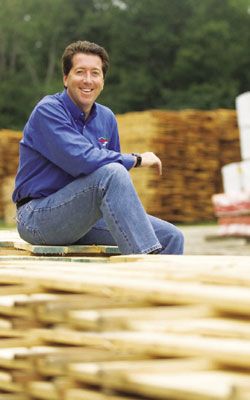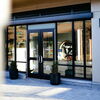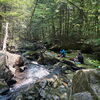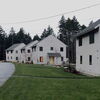Processing Your Payment
Please do not leave this page until complete. This can take a few moments.
- News
-
Editions
View Digital Editions
Biweekly Issues
- December 1, 2025
- Nov. 17, 2025
- November 03, 2025
- October 20, 2025
- October 6, 2025
- September 22, 2025
- + More
Special Editions
- Lists
- Viewpoints
-
Our Events
Event Info
Award Honorees
- Calendar
- Biz Marketplace
Hancock Lumber takes advantage of global demand for Maine's prized tree
 photo/Courtesy Hancock Lumber
Hancock Lumber CEO Kevin Hancock credits the company's growth in international exports to its familiarity with its flagship product, Eastern white pine
photo/Courtesy Hancock Lumber
Hancock Lumber CEO Kevin Hancock credits the company's growth in international exports to its familiarity with its flagship product, Eastern white pine
Growing up to 150 feet tall, the Eastern white pine tree is a hallmark of the Maine landscape. The tallest tree in eastern North America, Eastern whites were once known as "mast pines" and were reserved for the British Royal Navy.
Luckily for Hancock Lumber CEO Kevin Hancock, they also make one heck of a TV tray.
Bolstered by increased international sales of their Eastern white pine to locations like Canada, China and Pakistan, Hancock Lumber was named 2011 Exporter of the Year by the Maine International Trade Center.
Growing demand for Maine wood products on the international market have increased sales of "appearance grade" woods like Eastern white pine, the only species of tree that Hancock handles.
Prized by foreign manufacturers as a rustic, decorative wood, Eastern white pine is used in everything from siding and edging to paneling, furniture and, yes, television dinner trays.
Hancock credits the increased international sales to a growing foreign manufacturing sector that is becoming more discerning about the quality of their raw materials.
"Manufacturers have specific characteristics they need in wood, and that species might not be abundant in a place like China. A lot of things are being assembled in China, but they don't necessarily have the right raw materials available," says Hancock.
The recognition as exporter of the year was a welcome surprise for the company, which has only been exporting in earnest since 2007.
Two factors contributed to the company's decision to expand into the international market, according to Hancock: the erosion of the North American housing market and increased global demand for American wood products. "We didn't create the new market, the new market started to make itself available and we took advantage of it," says Hancock.
Since 1848, Hancock Lumber has made a name as one of the leading manufacturers of lumber for the domestic housing market. Employing 200 in the companies's sawmills in Casco, Bethel and Pittsfield, Hancock saw over 50 million boards of Eastern white pine pass through its mills in 2011. "We are one of the largest pine manufactures in the Northeast. I think our size has definitely been a factor," says Hancock.
While approximately two-thirds of Hancock's business comes from its 10 retail locations across Maine and New Hampshire, the company's sawmill operations have made great strides in introducing their unique, made-to-order product in the international market.
"There are a lot of different species of wood that compete with ours, but Eastern white pine typically has a list of characteristics that users like: It's very white, it has a crisp, bright appearance and the knot configuration has a rustic flavor to it," making the product perfect for "lake or mountain homes, cottages and rustic living," says Hancock.
Hancock's export of Eastern white pine has grown rapidly in the last five years and now accounts for roughly 25% of its sales. "It's gone from being essentially zero to one out of every four boards we produce [are bound] for export," he says.
In trying to market the species to overseas manufacturers, Hancock embraced a bold selling point: total customization. "Within our manufacturing operations we've [established] a culture of flexibility where we've really been able to identify customer's needs and tailor our manufacturing processes to be able to make their products," says Hancock. "We've just been very willing to reinvent our products and adapt them to these markets to diversify our customer base. It takes volume and it takes a certain mindset as well because it definitely requires changing your manufacturing [processes]."
Hancock is one of the few remaining lumber companies still growing its own trees, with 12,500 acres of timberland in Cumberland and Oxford counties to its name. Hancock says the familiarity with their sole species of lumber has allowed the company to become experts in its growing, milling and marketing. "We are a fully integrated operation. We're growing the trees, manufacturing the lumber and doing retail," Hancock says.
Mainebiz spoke with Hancock recently about the marketability of the prized pine. The following is an edited transcript.
Mainebiz: Canada has long been a leading lumber exporter. How was Hancock able to break into this established market and make the country your leading importer of Eastern white pine?
Kevin Hancock: Yes, traditionally lumber has flowed the other way, but Canada is a large market. Eastern white pine is just not readily available in Canada; there are not enough resources in terms of trees and manufacturers. Framing lumber would be a different story because there is not a significant need to export it to Canada, but our particular product line has a place there. The Canadian market would be more like the American market in that it is [used] primarily in housing [whereas] markets like Mexico, China and Europe are primarily manufacturing.
Has a slumping housing market and trend toward smaller houses/renovation over new construction affected your business?
The short answer is yes. With fewer homes being built, the housing market is roughly 40% the size it was in 2005, and the homes that are being built are smaller so the demand in housing is dramatically different than it would have been five to seven years ago. As far as renovation, yes, for sure, because our product is commonly used as trim or casing, or for paneling, cabinetry or shelving.
Can you explain your strategy for expanding into the global market? Has there been an over-arching strategy?
It's just something that tends to tip. What's happened is that once we've gotten out into the global market, one market has led us to another and it tends to keep building on itself. If certain markets are growing, we take advantage of that. Right now we are doing some work in Japan and [looking at] Mexico.
We're not really looking to create markets — we're just trying to be globally aware and see and access the largest possible number of market so we can pick [those] that are the best fit for our customers and our company. When we pick an export client, it's not just to say we did it, it's because at this point in time this particular [market] is a more profitable destination for that product. Focusing on export opportunities has given us a bigger menu of clients to select from.
What are some examples of uses of Eastern white pine in the growing Chinese market?
In China, our market is in manufacturing. We have one customer that makes frames using little strips of pine and they like the product because it doesn't warp or twist or anything. Another Chinese customer makes TV tables, furniture, shelving, tabletops and countertops. They like it because it's workable and holds stain well.
Does Eastern white pine have the potential to be a Maine legacy product like blueberries, lobsters or potatoes?
At the consumer level, probably not. The big difference is that lobsters and blueberries are for public consumption, they are consumer products. Ours tends to be more secondary, we're selling to builders and manufactures so I don't think the typical consumer outside of Maine would necessarily distinguish between Eastern white pine and other products.
Mainebiz web partners

The Giving Guide
The Giving Guide helps nonprofits have the opportunity to showcase and differentiate their organizations so that businesses better understand how they can contribute to a nonprofit’s mission and work.
Learn More
Work for ME
Work for ME is a workforce development tool to help Maine’s employers target Maine’s emerging workforce. Work for ME highlights each industry, its impact on Maine’s economy, the jobs available to entry-level workers, the training and education needed to get a career started.
Learn More
Groundbreaking Maine
Whether you’re a developer, financer, architect, or industry enthusiast, Groundbreaking Maine is crafted to be your go-to source for valuable insights in Maine’s real estate and construction community.
Learn more-
The Giving Guide
The Giving Guide helps nonprofits have the opportunity to showcase and differentiate their organizations so that businesses better understand how they can contribute to a nonprofit’s mission and work.
-
Work for ME
Work for ME is a workforce development tool to help Maine’s employers target Maine’s emerging workforce. Work for ME highlights each industry, its impact on Maine’s economy, the jobs available to entry-level workers, the training and education needed to get a career started.
-
Groundbreaking Maine
Whether you’re a developer, financer, architect, or industry enthusiast, Groundbreaking Maine is crafted to be your go-to source for valuable insights in Maine’s real estate and construction community.
ABOUT
NEW ENGLAND BUSINESS MEDIA SITES
No articles left
Get access now
In order to use this feature, we need some information from you. You can also login or register for a free account.
By clicking submit you are agreeing to our cookie usage and Privacy Policy
Already have an account? Login
Already have an account? Login
Want to create an account? Register
Get access now
In order to use this feature, we need some information from you. You can also login or register for a free account.
By clicking submit you are agreeing to our cookie usage and Privacy Policy
Already have an account? Login
Already have an account? Login
Want to create an account? Register







Comments